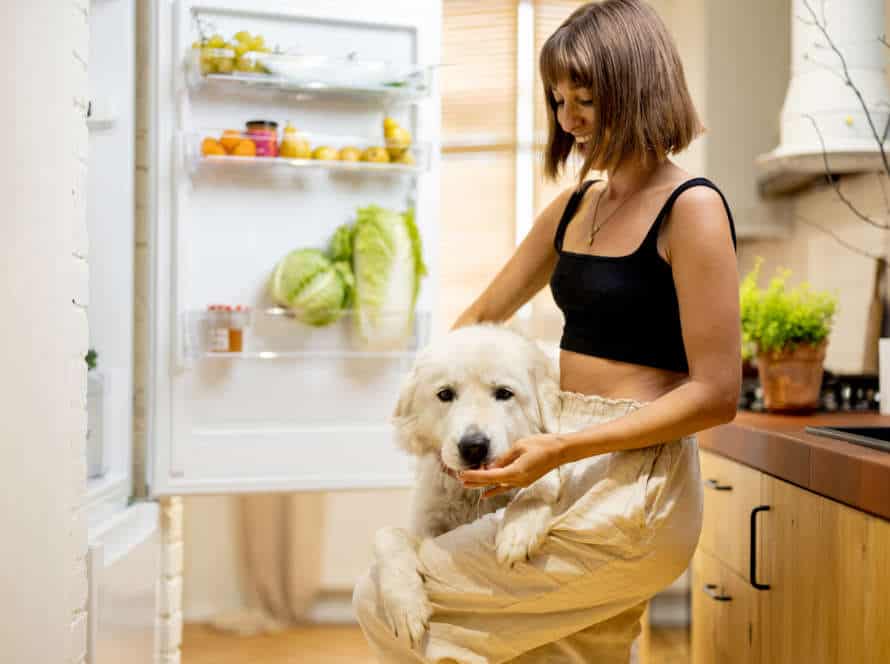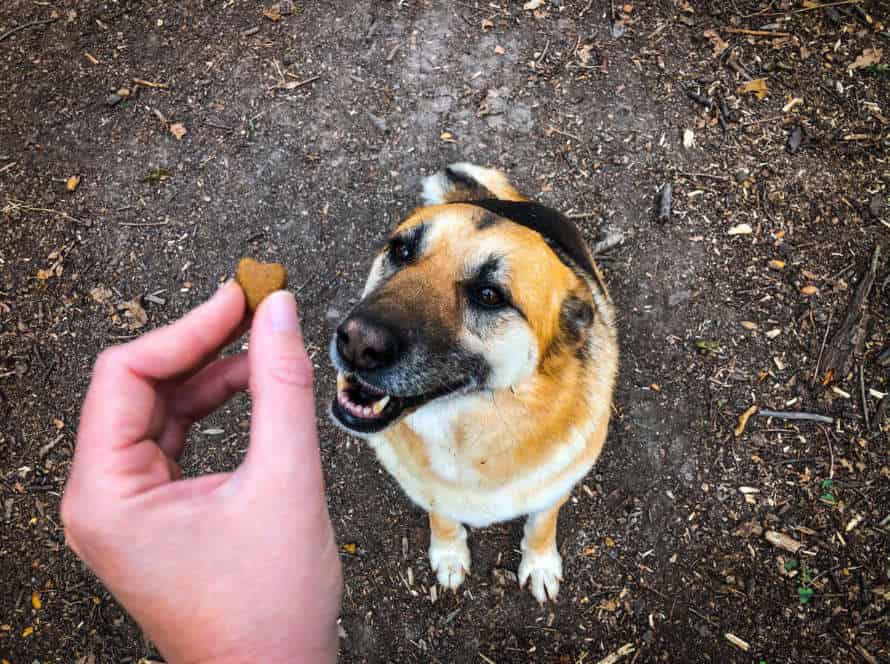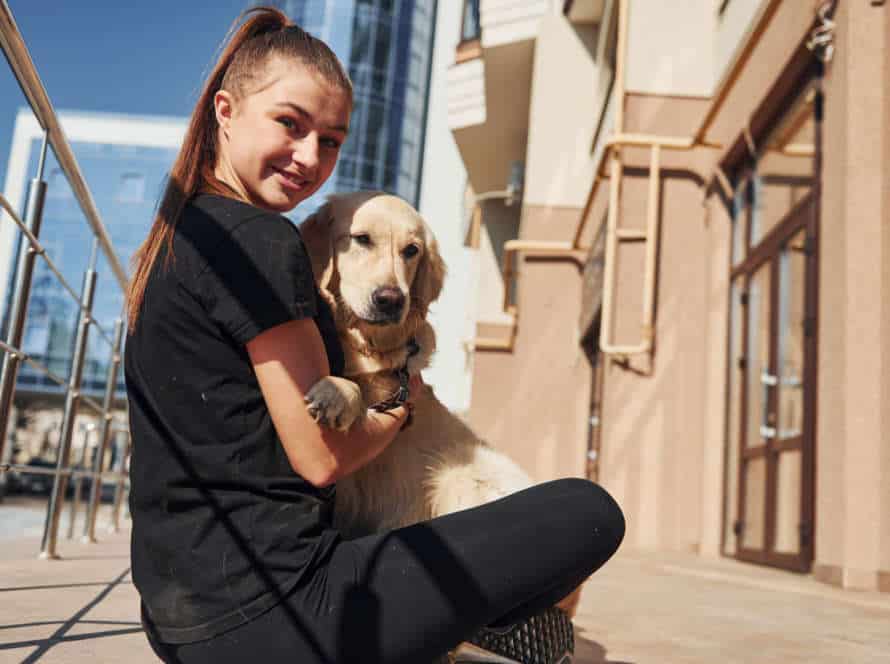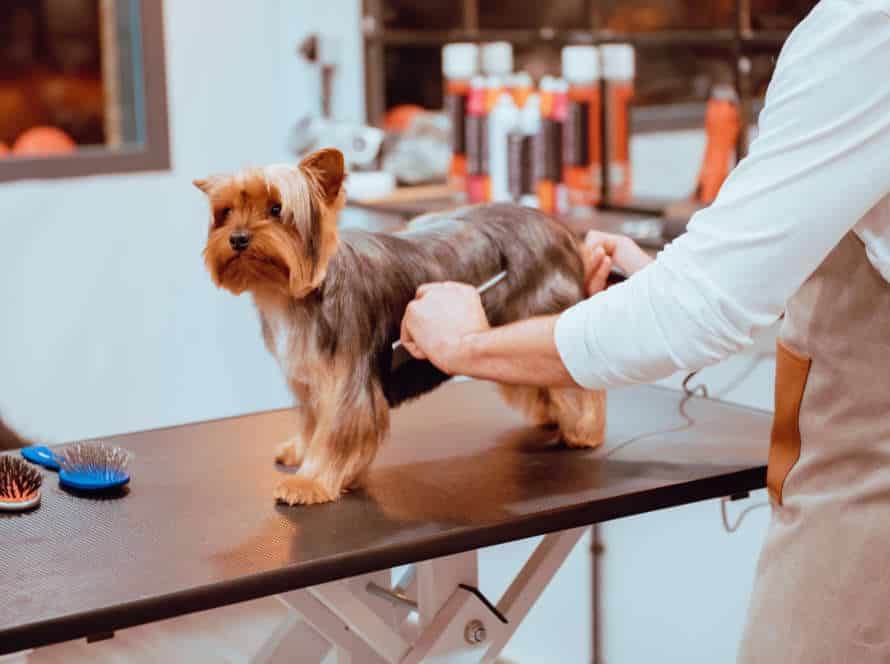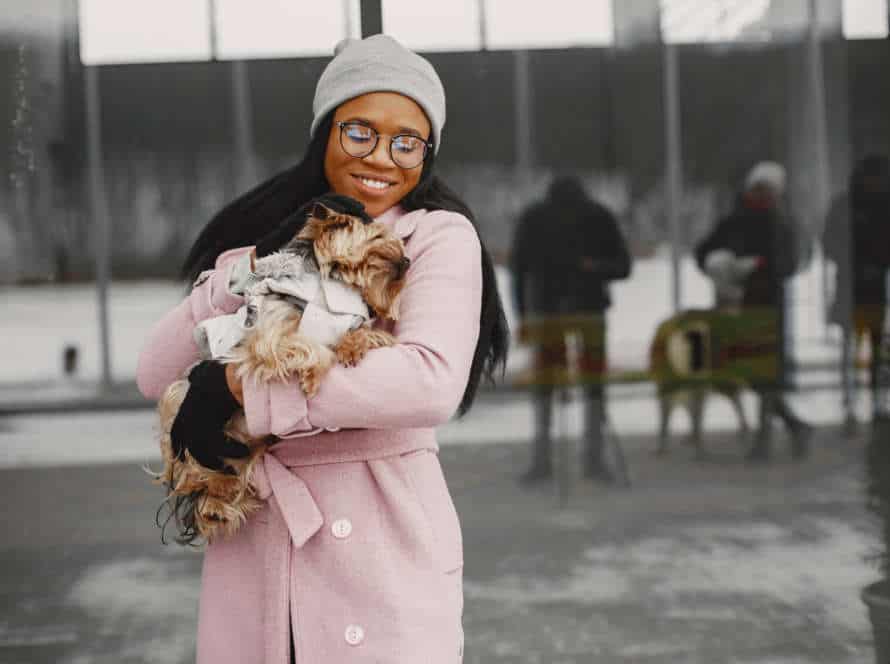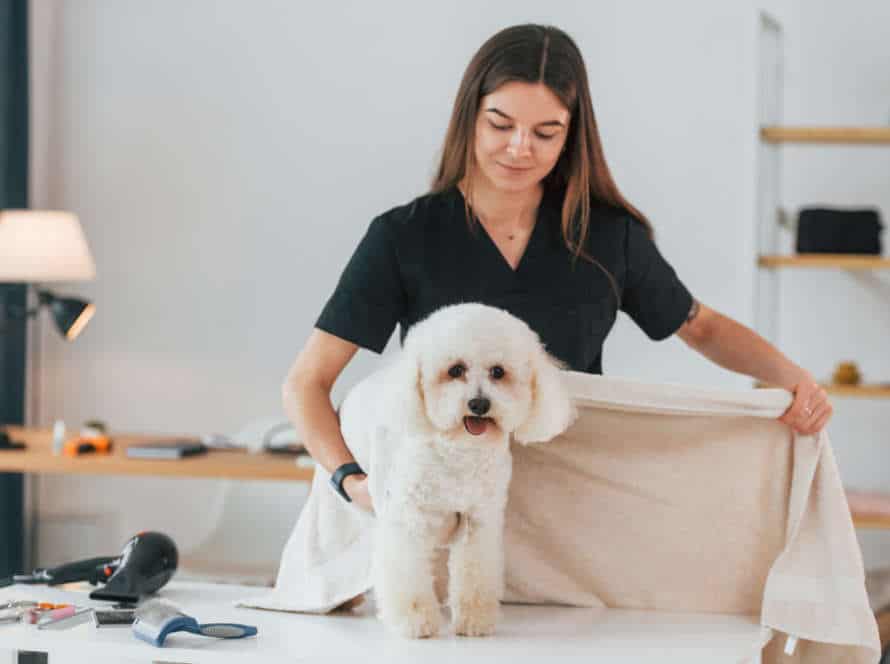A Comprehensive Guide to Grooming Routines for Senior Dogs
As your pooch ages, their grooming routine may need to change for them to stay comfy and in good health. Here’s a guide to grooming routines for senior dogs.
- Dental Care: Senior dogs have an increased likelihood of dental issues. Brush their teeth regularly. Give them dental chews. Take them for regular dental checkups.
- Coat Care & Brushing: Brushing helps spread natural oils and remove fur, debris, and tangles. But older dogs may have sensitive skin, so use a soft-bristled brush and be gentle.
- Bathing: Bathe your senior dog only when necessary. Use mild shampoos designed for sensitive skin or older dogs.
- Nail Trimming: Trim their nails every 3 to 4 weeks or per their growth rate. If you’re not confident doing it, take them to a groomer or vet.
- Ears & Eyes: Regularly check their ears and eyes for infections or other problems. Clean the ears with a damp cloth. Wipe around their eyes with a clean, damp cloth.
Pro Tip: If your senior dog has mobility difficulties, get a groomer who does in-home services. This will reduce stress and discomfort.
Understanding the Importance of Grooming for Senior Dogs
Caring for senior dogs is essential for pet parents. Grooming is a vital part of this care. It helps senior dogs stay healthy and comfy. It also makes their coat shine and prevents skin and coat problems. Let’s explore the importance of grooming for senior dogs.
The physical and mental health benefits of grooming for senior dogs
Grooming isn’t just about appearances. It can also provide physical and mental benefits for senior dogs.
Physical Benefits:
- Regular grooming can detect and stop skin infections, mats, fleas and ticks that can cause inflammation, hair loss and infections.
- It also improves circulation, encourages healthy hair growth and moisturizes the skin.
Mental Benefits:
- Grooming is a great way to bond with your senior dog, reducing stress and anxiety.
- It releases feel-good hormones like endorphins, serotonin and oxytocin, making your pup feel better.
Pro tip: Set up a routine like brushing, bathing, nail clipping and ear cleaning. Be sure to reward your pup with treats and praise for positive behavior!
Signs that your senior dog requires more frequent grooming
As dogs age, it’s vital to be aware of their grooming requirements. Here are some signs that your senior pup needs more regular grooming:
- Matted fur: Older dogs may have trouble grooming themselves, so their fur gets tangled and matted. This can be uncomfortable and even painful.
- Skin irritations: Senior dogs often have dry, itchy skin. This can cause hot spots or infections if not cared for.
- Overgrown nails: Older dogs may not be as active, leading to slower nail growth. But long nails can be painful and interfere with their mobility.
- Dental problems: Oral hygiene is essential for all dogs, but especially for senior dogs. They can be more prone to dental disease.
Regular grooming can help avoid these issues and keep your senior dog healthy and comfortable in their old age.
The role of grooming in senior dog’s socialization and bonding with humans
Grooming is important for senior dogs. They need more care as they age. Grooming not just makes them look good but helps their mental health too. It helps them bond with humans and offers social benefits. Grooming also helps detect skin issues, infections, or allergies. To groom them properly, you should bathe them regularly, trim their nails, brush and detangle their fur/hair, clean their eyes and ears. Don’t forget to feed them a balanced, nutritious diet too. Show your senior furry friend love, empathy and value their companionship by grooming them properly.
Essential Tools and Supplies for Grooming Senior Dogs
Grooming a senior pup can be intimidating. But, with the correct tools and supplies, it’s achievable safely and quickly. In this guide, we’ll show the key tools and supplies you’ll require for grooming your elderly canine. We’ll talk all about the appropriate clippers and brushes, plus shampoos and conditioners. Get ready to learn the ins and outs of grooming senior dogs!
Brushing and combing tools for senior dog’s coat
Brushing and combing are important for grooming a senior dog’s coat. Here are the best brushes and combs to use:
- Slicker Brush: Perfect for medium to long-haired dogs. It removes matts, tangles and loose fur.
- Bristle Brush: This is great for short-haired coats. It removes dirt and debris, making the coat smooth.
- Undercoat Rake: Necessary for double coats. Removes loose fur from the undercoat, helping to reduce shedding.
- Dematting Comb: Used to get rid of mats and tangled fur. Good for long-haired dogs who are prone to developing mats.
- Shedding Blade: Ideal for heavy-shedding breeds. It takes away loose fur from the undercoat, lessening shedding.
Choosing the right grooming tools for a senior dog’s coat is essential for keeping their coat healthy and shiny.
Specialized grooming products for senior dog’s skin and coat
As your pup gets older, be sure to give them the love and care they deserve. That includes their fur and skin. Using specialized grooming products made for senior dogs can help keep their coat and skin healthy. Here’re some useful grooming products:
- A sensitive skin shampoo – ideal for elderly dogs with sensitive skin.
- Detangling spray – great for when their coats get matted.
- Bristle brush – helps with thinning fur.
- Nail clippers – delicate, brittle nails are harder to cut.
- Dental chew treats – keep their mouths clean and breath fresh.
Pro Tip: Chat with your vet to find out the best products for your senior pup’s coat and skin care. They’ll know what’s best for your pooch!
Nail clippers and files for senior dog’s paw care
Nail clippers and files are key for senior dog paw care. Using them regularly stops issues like ingrown nails and paw pad injuries. Two types of clippers exist: scissor style and guillotine style. Scissor style is safer and easier to handle, while guillotine clippers work better on thicker nails. Filing can be done with a manual file or electric grinder. This smooths the nails and stops them from snagging on furniture or carpets. Avoid using human clippers and scissors on your senior dog, as they could cause pain and trauma. Pro Tip: Have styptic powder ready in case you cut the nails too short.
Bathing and Drying Senior Dogs
Bathing and drying your senior pooch is a must! Doing this keeps their fur in tip-top shape and removes grime, dirt, and any other nasties. To help you out, we’ve put together a guide on how to properly bathe and dry your senior pup. You’ll learn what products and techniques to use.
How to bathe a senior dog with special needs and limitations
Bathing a senior pup with special needs and restrictions demands a special strategy. To make it comfy and risk-free, here’s a detailed guide:
- Set up the bathing area: Arrange a non-slip floor and fill the tub with lukewarm H2O.
- Choose a calming shampoo: Go for a dog shampoo made specifically for seniors and delicate skin.
- Shield their eyes and ears: Place cotton balls in their ears and put on a soft shower cap over their eyes.
- Take it slow and be tender: Support your pooch throughout the bath and move slowly to avoid overstimulating them.
- Dry them completely: Use a gentle towel to dry your pup and stay away from a blow dryer, which can be too loud and uncomfortable.
By following these steps, you can make sure your senior dog gets the delicate and supportive grooming they need while keeping them clean and relaxed.
Safe and effective drying techniques for senior dog’s skin and coat
To shield senior dogs from discomfort or harm, here are some tips for drying their skin and coat:
- After bathing, use a soft and absorbent towel to pat the dog’s skin and coat dry.
- No hairdryers or heat-producing tools. They may burn or irritate.
- Low-heat pet dryers are an alternate for quick drying.
- A slicker brush or comb to detangle the coat and avoid matting.
- Check the dog’s skin and coat for irritation, redness, or sensitivity before and after drying.
This will help keep your senior dog’s skin and coat in good health and out of harm’s way.
How frequently to bathe a senior dog and which shampoos to use
Senior dogs don’t need too many baths. Maximum once every 3 months, or when they appear dirty or their coat is oily. When choosing shampoo, go for mild and hypoallergenic formulas made for senior dogs. Avoid shampoos with harsh chemicals, scents, or sulfates. Earthbath Oatmeal & Aloe Dog Shampoo, Vet’s Best Hypo-Allergenic Dog Shampoo, and Pro Pet Works Hypoallergenic Oatmeal Dog Shampoo are good options. Use lukewarm water for the bath. Begin with a gentle massage, rinse well. When done, use a towel or blow dryer on low setting to dry your senior dog.
Trimming and Shaving Senior Dogs
Trimming and shaving your elderly pup’s fur is vital for grooming. It will make them comfy, especially in the hot months. But, remember – different types of fur and age-related problems can complicate trimming and shaving. Let’s look at the best way to trim and shave senior dogs.
How to trim and shave senior dogs with sensitive skin
Grooming a senior pup can be tough, especially if they have delicate skin. It’s essential to make sure it doesn’t cause them any pain. Here are some tips to make it easier:
- Start by brushing their fur to get rid of knots or mats that can make them itchy.
- Use clippers with a sharp blade to trim their hair bit by bit. Don’t cut it too close to the skin to stop skin issues.
- Take regular breaks to keep your doggo from getting too hot.
- Use a mild shampoo for old pooches with sensitive skin to wash loose fur away.
- After that, put on a gentle and calming conditioner to stop itching.
- Always check your pup for signs of pain or unease during grooming and see a vet if needed.
Pro Tip: Give your senior pup plenty of treats and compliments to stay relaxed.
Common grooming styles for senior dogs and how to achieve them
Grooming senior dogs? Different techniques and styles are needed for them than for younger pups! Here’s the low-down on the common grooming styles for senior dogs:
- The Puppy Cut: Trim their fur to an even, short length all over their body. Great for thinning or matted fur – prevents tangles & matting.
- The Teddy Bear Cut: Trim the body fur short and leave the head & ears fluffy. Suitable for all breeds and great for shedding dogs.
- The Lion Cut: Shave body fur short and leave hair on head, legs & tail long. Great for thick or curly fur – prevents overheating.
Pro Tip: Before grooming, brush the fur thoroughly to remove tangles or matting. Use rounded scissors to avoid any cuts or injuries.
Safety protocols for trimming and shaving senior dogs’ hair and fur
When it comes to grooming senior dogs, safety protocols should be followed. Here are tips to keep in mind:
- Start slowly. If your pup has never been groomed, let them get used to it before attempting a full haircut.
- Use tools designed for dogs. Keep them clean and sharp.
- Be careful when using clippers. Don’t press too hard against the skin.
- Keep your dog calm. Use calming techniques like music, treats, or massage.
- Know your pup’s limits. If they have health or mobility issues, consult a professional groomer.
By following these safety protocols, you can groom your senior pup safely and make them look and feel great.
Dental Care for Senior Dogs
Dental care for senior dogs is essential. As a pet owner, it’s important to watch out for signs of tartar or plaque. Ensure their teeth are clean and free of debris. In this article, we’ll discuss the importance of dental care for elderly canines. Plus, tips on how to keep their teeth in top shape!
The importance of canine dental hygiene for senior dogs
Dental care is important for senior pup health. Neglecting it can cause bad breath, gum disease, tooth decay and even heart and kidney problems. Here’s a guide:
- Brush their teeth with a doggy toothbrush and toothpaste.
- Give them chews and toys that help teeth and gums.
- Feed them a balanced diet with wet and dry food.
- Schedule regular dental check-ups with your vet.
- Monitor their behavior and appetite, any changes might mean dental issues.
- Check their breath, an early sign of dental problems.
Pro-tip: Regular vet exams and cleanings help keep senior pup teeth healthy and avoid tooth loss.
How to brush senior dogs’ teeth: tips and tricks
Maintaining a senior dog’s dental health is essential. Here’s some advice to make brushing stress-free for both you and your pet.
- Invest in a toothbrush and toothpaste created just for dogs.
- Introduce brushing gradually and reward your pup with treats.
- Position yourselves comfortably and securely.
- Start by massaging their teeth and gums with a finger covered in gauze.
- Gently brush in circular motions, focusing on the outside of the teeth.
- Keep giving them praise and treats throughout the process.
- If your furry friend resists brushing, talk to your vet about different dental care options.
Pro tip: Professional cleanings and regular check-ups are important too.
Dental care products for senior dogs: toothpaste, chews, and toys
Essential for senior dog health and wellbeing is dental care. Using the correct dental products can help stop tooth decay, gum disease, and more dental issues.
Toothpaste: Get special toothpaste made for senior dogs. It contains enzymes to break down plaque and tartar. Use a soft-bristled toothbrush to brush their teeth 2-3 times a week.
Dental chews: For plaque and fresher breath, try dental chews. Make sure the chew toys are not too hard, as it could harm your dog’s teeth.
Chew toys: Cleaning teeth and entertainment, chew toys are great. Pick ones that are safe and durable. They should encourage exercise for optimal dental health.
Regular grooming and appropriate dental care products helps senior dogs stay healthy and happy.
Pro tip: Don’t use human toothpaste on dogs, it’s hazardous.
Senior Dog Grooming: Tips and Tricks
Grooming your senior pup can be tricky. Be gentle and mindful of their changing needs. Regular grooming is key to avoid any large mats and skin issues. Here are some tips and tricks for safe grooming of your senior dog, and keeping their coat in tip-top shape.
How to deal with common grooming problems in senior dogs
Grooming senior dogs is tricky, due to age-related issues. Here are some tips for tackling common grooming problems:
- Brushing: Use a soft-bristled brush. Detangling spray helps stop knots and mats.
- Bathing: Use lukewarm water and mild shampoo. Dry your dog to avoid skin infections.
- Nail Trimming: Trim nails regularly. Avoid cutting the quick. A nail grinder helps file down nails.
- Dental Care: Brush teeth regularly. Take them for dental checkups. Offer dental chews/toys.
Pro Tip: Use a raised grooming table or non-slip mat. It prevents falls and provides better traction.
Techniques to keep senior dogs calm and relaxed during grooming sessions
It’s important to keep senior dogs calm and relaxed during grooming sessions. Here are some tips:
- Introduce your pup to grooming tools like brushes and clippers slowly, to get them used to the process.
- Give treats and praise for good behaviour.
- Make grooming sessions short, with time for breaks.
- Account for your pet’s physical needs, like joint pain or arthritis. Move gently and avoid tugging.
- Set up a calming environment with music and aromatherapy.
Plus, regular grooming keeps them clean and healthy, preventing skin issues and matting!
Ways to improve senior dog’s coat and skin health through grooming routines.
As your pup ages, it’s vital to focus on their coat and skin health. Here’s how to keep ’em in tip-top shape:
- Brush: Regularly brush to remove tangles and mats that can cause skin irritation.
- Bathe: Give them a bath as advised by your vet. Use mild shampoo and conditioner for senior dogs to avoid stripping natural oils.
- Trim: Keep their coat trimmed. Less shedding and mats!
- Supplements: Give omega-3, vitamin E, and biotin supplements to help their coat and skin.
- Check-ups: Take ’em to the vet regularly to address any skin issues or allergies.
By following these routines, your senior pup can look great for years to come!
Frequently Asked Questions
Q: Why is grooming important for senior dogs?
A: Grooming helps senior dogs maintain good hygiene, prevent skin irritations and infections, and keeps them comfortable and healthy.
Q: How often should I bathe my senior dog?
A: It is recommended to bathe senior dogs every 4-6 weeks, depending on their activity level and if they have any skin conditions or allergies.
Q: What kind of brush should I use for my senior dog?
A: For dogs with long hair, a slicker brush is recommended to remove mats and tangles. For dogs with shorter hair, a bristle brush can help remove loose fur and dirt.
Q: Why is it important to trim my senior dog’s nails?
A: Overgrown nails can cause discomfort, pain, and even affect the way a dog walks. Trimming nails regularly prevents these issues and helps maintain good paw health.
Q: How often should I clean my senior dog’s ears?
A: Cleaning your senior dog’s ears once a week can help prevent infections and remove dirt and wax build-up. If your dog is prone to ear infections, consult with your veterinarian for a specific cleaning schedule.
Q: Should I consider professional grooming services for my senior dog?
A: Professional groomers can provide additional services, such as teeth cleaning and anal gland expressions, and have experience handling senior dogs. However, if your senior dog is anxious or has health issues, it may be less stressful to groom them at home.


